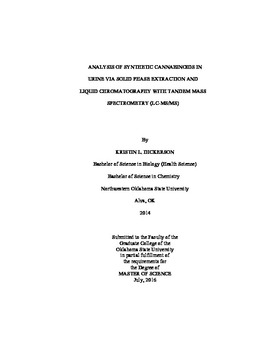| dc.contributor.advisor | Wagner, Jarrad R. | |
| dc.contributor.author | Dickerson, Kristin LeAnn | |
| dc.date.accessioned | 2018-06-29T14:41:00Z | |
| dc.date.available | 2018-06-29T14:41:00Z | |
| dc.date.issued | 2016-07-01 | |
| dc.identifier.uri | https://hdl.handle.net/11244/300349 | |
| dc.description.abstract | Synthetic cannabinoids have emerged as a dangerous new trend in illicit drug use.The appointment of many popular synthetic cannabinoids as Schedule I controlledsubstances has helped to decrease their popularity in recent years, but in order to enforce the new legislation, methods must be developed to detect the drugs in biological samples. The purpose of this study was to improve the detection of synthetic cannabinoids in urine. An LC-MS/MS method was developed to detect 14 synthetic cannabinoid parent compounds and metabolites, and THC. Comparison studies were performed to determine the conditions for the extraction of the target analytes via solid phase extraction (SPE).The suitability of three different SPE columns and three different eluents wereanalyzed during two different studies by extracting spiked urine samples and comparing the resulting peak areas. The effect of methanol wash solutions was analyzed by washing the columns with 30% methanol, 70% methanol, and 100% water solutions. A 10% acetonitrile reconstitution solution and 20% methanol reconstitution solution were compared to determine which was better suited for the recovery of the target analytes. Finally, linearity, carryover, and matrix effects validation studies were performed on the final method.The column and elution comparison studies revealed that the SPEware CEREX®HP SAX 5 mg NBE column paired with a DCM:IPA:NH4OH elution performed best for the target analytes. The methanol wash study showed that high methanol content in the wash solvent resulted in analyte loss during extraction. The 100% water wash was determined to be most favorable for the extraction of synthetic cannabinoids. The 20% methanol solution greatly improved the recovery of all analytes. The calibration curve included a 1c, 2c, 5c, 10c, 15c, and 25c for all analytes except THC which did not use a 1c calibrator. The linearity study showed that linear calibration models worked for some analytes, while others required a quadratic fit model. No carryover was observed at the upper limit of quantitation. Matrix effects ranged between 64% and 270%. Recovery efficiencies were 12-158%, and process efficiencies were 12-417%. | |
| dc.format | application/pdf | |
| dc.language | en_US | |
| dc.rights | Copyright is held by the author who has granted the Oklahoma State University Library the non-exclusive right to share this material in its institutional repository. Contact Digital Library Services at lib-dls@okstate.edu or 405-744-9161 for the permission policy on the use, reproduction or distribution of this material. | |
| dc.title | Analysis of Synthetic Cannabinoids in Urine via Solid Phase Extraction and Liquid Chromatography with Tandem Mass Spectrometry (LC-MS/MS) | |
| dc.contributor.committeeMember | Thrasher, Ronald R. | |
| dc.contributor.committeeMember | Payton, Mark | |
| osu.filename | Dickerson_okstate_0664M_14839.pdf | |
| osu.accesstype | Open Access | |
| dc.description.department | Forensic Science | |
| dc.type.genre | Thesis | |
| dc.type.material | text | |
